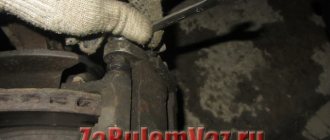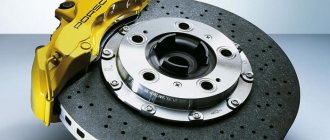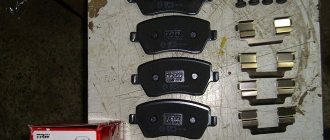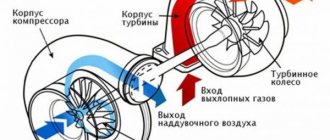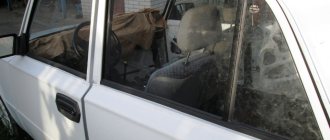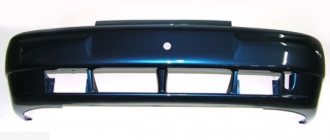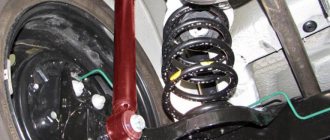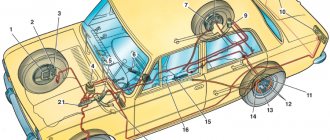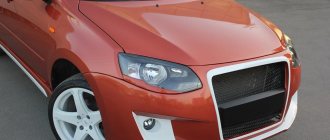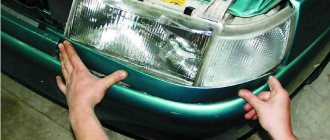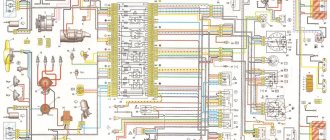Brake pedal
The main control element of the VAZ 2101 braking system is the brake pedal, located in the cabin under the steering column between the clutch and accelerator pedals. The pedal transmits the muscular force from the driver's legs to the GTZ. If the brake pedal is adjusted correctly, the free play will be 4–6 cm. When you press it and travel the specified distance, the vehicle begins to smoothly slow down.
Free play of the brake pedal: 1 — master cylinder; 2 - pusher; 3 — brake pedal; 4 — brake light switch buffer; 5 — switch nut; 6 — brake light switch; 7 — pedal release spring
Step-by-step instructions for dismantling the VAZ 2106 caliper
First you need to jack up the car and remove the front wheel. Then spray all the fastening nuts and bolts with penetrating lubricant, as they usually are very difficult to unscrew.
Next, use a screwdriver to bend the fixing plate, which is pressed against the brake hose bolt. You can clearly see this operation in the photo:
We bend it upward so that you can freely throw on the key and unscrew the brake hose bolt:
And after that, freely remove the hose and move it to the side so that it does not interfere in the future:
The next step is to unscrew the two caliper mounting bolts, one of which is located at the bottom, and is clearly shown in the picture:
First, we tear off the bolt with a head and a wrench, since a lot of force will have to be applied, and then it is best to use the ratchet handle to do everything as quickly and conveniently as possible:
And the second bolt, which is located at the top, also needs to be unscrewed in the manner described above:
Since there are no more brake caliper mounts, you can now freely remove it from its place, as shown in the photo:
Now everything is ready, I think now no one will have any questions about how to remove the caliper from the car. If you decide to replace this part, then the price of a new one is about 1,500 rubles. Installation proceeds in reverse order.
The front brake caliper is removed if it is necessary to replace it, as well as when performing work related to replacing the brake disc or working cylinders. It will be more convenient to carry out all work if you hang the car on a lift. To complete the work you will need only three tools, namely: a screwdriver and a pair of wrenches 14 and 17.
Operating procedure:
The wheel is removed and then the bolt securing the brake hose bracket to the caliper is unscrewed, after which the bracket and spring washer are removed.
Unscrew the fastening bolt and remove the brake hose and special sealing washer. There will be a second washer on the caliper, which should also be removed. After unscrewing the hose, plug the hole through which brake fluid may leak with a rubber plug.
Remove the brake pads and bend the locking plates securing the caliper mounting bolts, unscrew the bolts and remove them together with the plates, after which the caliper itself is removed.
The front brake caliper has been removed, all that remains is to replace it with a new product and reassemble it in the reverse order of removal.
The VAZ 2107 brake caliper is a durable metal structure that serves to secure the brake cylinders. The caliper itself cannot be repaired and its removal is carried out mainly to replace jammed brake cylinders or when performing some other repair in which its presence will interfere with operation.
Let's look at the process of disassembling a brake caliper using the example of replacing working cylinders. To perform the repair, you will need a hammer, a flat-head screwdriver and pliers, as well as a special ten-size wrench for unscrewing the brake pipe fittings. Once you have everything you need, you can begin the repair.
- Having disassembled the front wheel brake mechanism and removed the caliper, it must be secured in a vice.
- Using a special wrench, unscrew the two fittings of the connecting brake pipe and remove it.
- Next, you need to press out the latch holding the brake cylinder using a thin flat-head screwdriver and at the same time knock the brake cylinder out of its seat.
At this point, the work on disassembling the VAZ 2107 brake caliper is completed. Replace the brake cylinders with new ones. When installing, do not forget that the brake cylinders are not interchangeable and each is installed in its place. Install in reverse order, installing the brake cylinder, and also pre-press the spring clip. As soon as the cylinder is in place, its lock will immediately engage. It often happens that new cylinders are very difficult to fit into place, as a rule, this is due to the presence of factory roughness on their surface. To prevent this from happening, treat the edges of the cylinder with a coarse file and lubricate the caliper guides with lithol, then carefully tap the cylinder with a hammer. After assembling the entire brake system, bleed the brakes. This completes the repair work.
Sources
- https://vaz2106-remont.ru/snyatie-supporta-perednego-kolesa/
- https://rem-vaz.ru/remont-vaz-2106/tormoz-sistema/kak-snyat-i-ustanovit-support-perednego-tormoznogo-mexanizma-vaz-2106-2103.html
- https://remont-vaz2106.ru/razborka-tormoznogo-supporta-vaz-2107
Where is the front caliper located?
A caliper is a kind of housing for the brake system of the front wheels, in which replaceable pads are mounted, as well as working cylinders. This part is made of steel. Located on the brake discs. The design of this device has parallel holes on both sides in which the brake cylinders are located. These cylinders drive pistons, which move when you press the brake pedal.
The pistons in the working cylinder act on the pads, which are pressed by a friction layer against the brake disc rotating with the wheel. Thus, the vehicle's movement slows down. Without this housing, it is almost impossible to implement a disc brake mechanism, therefore, when malfunctions of the device occur, they must be eliminated as quickly as possible. This mechanism fails extremely rarely, and it can last up to 500 thousand km, however, under the influence of certain factors, its service life can be reduced by 2-3 times.
The mechanism belongs to the category of non-repairable devices that, if they fail, need to be replaced. Exactly how to remove the caliper on a VAZ 2107 is discussed in detail in the material, which will allow not only beginners, but also experienced professionals to remember how to do it correctly.
What tools are needed for removal
Before you begin repairing or replacing the brake caliper on a VAZ 2107, you will need to find out what exactly caused the breakdown. Most often, the pads are changed; when the friction layer wears out, they must be replaced. However, to replace the pads, there is no need to remove the part.
In addition, the working cylinders may fail, and if they fail, they will need to be repaired or replaced. To make the replacement, you first have to remove the caliper. To dismantle it you will need tools and materials:
- The caliper is complete with new working cylinders. If the mechanism body itself is in good condition, then only the working cylinders, of which there are 2 in the design of each device, must be replaced.
- A set of keys for 10, 14 and 17.
- Slotted screwdriver.
- Pliers with a hammer.
- Jack and goatee.
After replacement, you will need to fill the brake fluid into the system and remove the air - bleed it.
Removing the caliper on a VAZ 2107
Removing the caliper on a VAZ 2107 car is performed in the following cases:
- If the slave cylinder needs to be repaired or replaced.
- In case of deformation and damage to the mechanism body.
Replacing brake calipers on a VAZ 2107 is performed in the following sequence:
- Pump out fluid from the brake system expansion tank if it is still serviceable. If it is not suitable, then you don’t have to do this, since when unscrewing the hoses, it will flow out of the system.
- First, the desired car wheel is lifted with a jack.
- Using a wrench, unscrew the bolt of the brake hose mounting bracket.
- Remove the bracket so that it does not interfere with subsequent manipulations.
- Unscrew the bolt securing the rubber hose.
- Remove the bolt from its seat. Remove the two o-rings.
- Drain the liquid from the hose into a previously prepared container. The liquid does not need to be drained, but to do this you will need to insert, for example, a wooden cap into the hole in the tip.
- Remove the cotter pins that secure the friction pad fingers.
- Remove the pins that secure the pads. To remove them you will need to use a beard and pliers.
- Remove the springs from the brake pads that hold them in place.
- Remove the friction pads. If you do not plan to change the pads, then you need to note which part and where it was located.
- Using pliers, straighten the lock washers on the bolts that secure the device.
- Unscrew the bolts that secure the mechanism to the steering knuckle.
- Remove the device from its seat.
When dismantling the caliper, you need to take into account that the brake mechanism mounting bolts have different head shapes. You need to remember or mark which bolt was removed from which seat.
How the repair is carried out
If the mechanism is damaged or there are deformations, it must be completely replaced. Repairing a VAZ 2107 caliper involves replacing non-working cylinders. The repair procedure is as follows:
- The device is fixed in the jaws of a vice.
- Unscrew the fastenings of the connecting metal tube. After this, the tube must be removed.
- Knock out the working cylinders from the guides.
- If there are none, remove the clamps and replace them with new cylinders.
- Place the cylinders in the guides, and then install the connecting tube, followed by tightening the fittings.
- If it is necessary to repair the brake cylinders on the caliper, then the essence of the repair actions is to change the rubber seals.
- To make repairs, you will need to remove the cylinder and then remove the rubber cap from the cylinder using a screwdriver.
- Press the piston out, then remove the sealing ring using a screwdriver.
- In place of the old ring you need to install a new one from the repair kit. The cylinder, as well as the piston and ring, must be lubricated with brake fluid.
- Install the piston into the mechanism cylinder.
How to easily and safely replace the steering wheel?
The operation of replacing the steering wheel is not particularly difficult, but safety precautions must be observed. The basic steps on how to remove the steering wheel have been described above, but in some cases the following tips may be needed:
Method #1. If the steering wheel sits firmly on the shaft and cannot be removed, then it is necessary to loosen the steering wheel nut as much as possible, but leave it one turn (to protect the teeth, nose and other parts of the face). Then sit in a chair and sharply and evenly hit the steering wheel with your palms from below, upward along the steering axis. After several such impacts, the steering wheel should fly off the shaft.
The main thing is to remember to leave the nut on one turn!
Method #2. To remove the steering wheel, you can use an old Zhiguli jack. The base of the jack needs to be rested against the steering shaft through a wooden spacer, wrap a rope around the steering wheel and throw it over the top of the jack. A piece of cloth (rag) should be placed at the point where the rope comes into contact with the steering wheel so as not to scratch the steering wheel. Next, gradually pull with a jack and remove the steering wheel. Do not forget to completely unscrew the steering wheel fastening nut, since in this case the steering wheel itself will gently “come off” from the shaft.
How to replace the brake master cylinder on a VAZ 2101-VAZ 2107?
Removal: 1) First, of course, you need to unscrew the top cover of the brake reservoir and then collect all the fluid from there, to do this you will have to disconnect two terminals (They are indicated by green arrows, but just remember where each one is connected) and then unscrew the cover beyond the edges ( Indicated by a blue arrow), when everything is done, put the cap aside and pump out all the brake fluid from the reservoir using a rubber bulb or a medical syringe, removing the needle from it.
2) Now unscrew with a wrench (If that doesn’t work, use a special wrench for bleeding), the nuts of the brake pipes (There are three pipes in total, the nuts of two are indicated by red arrows, the third nut is not visible in the photo, but the third pipe itself is indicated by a green arrow and another green arrow the location of this nut is shown, so you should not have any difficulties in finding it) and disconnect the tubes and then take them aside (But just remember where each one is connected, if necessary, mark all the tubes to make it clearer), after the operation is completed done, loosen the screws of the clamps (Indicated by blue arrows) and remove both hoses from the brake cylinder fittings (Again, remember where each hose is connected), and finally, unscrew the two nuts securing the master brake cylinder (Under them the spring washers are located, not lose them) and then remove the brake cylinder from the car.
Note! We will give you advice, since the brake pipes are bent in the place where they are connected to the brake cylinder, accordingly, all the brake fluid will not pour out of them, but only the one that will be in the bent part will pour out (Very little of it is there, so don’t worry too much) , so, air will not get into the system either (Unless, of course, you press the brake at this moment) and therefore you can safely install a new cylinder, screw all the brake pipes to it and connect all the hoses (But do not tighten the hoses and pipes to the end) , then pour brake fluid into the reservoir and watch it come out from under the nuts, at first the fluid will flow out through the nuts with air bubbles, then they will disappear and at this moment when there are no bubbles, tighten all the nuts and clamps until they stop, tighten the brake hoses ! (In this case, you don’t even need to bleed the brakes, but just in case, read the article entitled: “Bleeding the brakes on a classic”; it describes the symptoms that can help you understand when the brake system requires bleeding)
Installation: The new master brake cylinder is installed in the reverse order, connect the tubes and hoses to it correctly (If marks were made, then install everything according to them) and do not forget about bleeding if there are symptoms that it is required (A little higher we talk about all this in detail wrote) and by the way, do not fill the brake fluid that was in the reservoir back, only fill it with new one.
Additional video clip: Using the example of a VAZ 2105 car, you can see the procedure for replacing the master brake cylinder clearly, everything from start to finish, see the video below:
Replacing the rear brake cylinder of a VAZ 2101 is required if problems with stopping the car begin to appear. The rear wheels take on about 25% of the load when braking. If the cylinder fails, it stops opening the pads, most often it simply jams. It is advisable to replace it with a new one when a malfunction is detected.
Replacing front brake hoses
Replacing the front brake hoses on a VAZ 2107 is not a difficult procedure, and before performing it, you need to pump out the fluid from the expansion tank. To pump it out, it is better to use a rubber bulb or syringe. Before you start doing the work, you will need to grab a tool and get started.
- First, let's start removing the front wheel from the desired side. We remove the front wheel in order to free access to the hose.
- When access to the eyeliner opens, you must first clean the joints with a wire brush, and then treat them with WD-40 or similar lubricant.
- 5-10 minutes after treating the connections with lubricant, you can begin to unscrew the fittings. To do this, use a special 10 mm key with a slot.
- The key has a special stopper in the form of a bolt, which is screwed in after it is put on the metal tube.
- We proceed to loosen the bracket nut, for which you need to hold the fitting with a key “17”.
- As soon as the connecting coupling on the metal tube is loosened, you can remove the special key and continue unscrewing by hand.
- After disconnecting the hose, a rubber boot must be placed on the end of the tube to prevent dust or water from entering the system.
- To release the second end of the fitting from the bracket, you will need to remove the bracket with pliers.
- Using a flathead screwdriver, unscrew the screw that holds the trim bracket to the caliper. After this, you can dismantle the part.
New hose in place - Using a “14” wrench, you need to unscrew the bolt securing the second fitting.
- The copper washers must be replaced, and then proceed to install the new hose on the caliper. It is important to take into account one nuance - the tip of the fitting should be directed downward, not upward.
Read, it may come in handy: How to find what is creaking - insidious acoustics
After screwing the second fitting, you can begin to perform similar actions, but on the other front wheel. This completes the installation of the front hoses, but do not rush to install the wheels in place, as you will need to perform the procedure of removing air from the system (bleeding the brakes).
Install and screw the locking bracket
Installing the brake caliper
Installation of the brake caliper on the VAZ 2107 is carried out in the reverse order of its dismantling.
After installing the brake caliper, it is imperative to bleed the brake system, removing air from it. Until this operation is completed, operating the vehicle is strictly prohibited.
The left and right wheel calipers are slightly different, so you need to pay attention to this when purchasing new ones. After repairing and installing the VAZ 2107 brake caliper, it is necessary to check the brake system for fluid leaks and, if necessary, repair them
After repairing and installing the VAZ 2107 brake caliper, it is necessary to check the brake system for fluid leaks and, if necessary, repair them.
Didn't find the information you are looking for? on our forum.
We recommend reading:
Why does the battery charging light on the VAZ 2106 blink?
How to set the ignition on a VAZ 21099
How to change the cylinder head gasket for a VAZ 2110 8 valve
Adjusting the electronic ignition on a VAZ 2106
How to connect the stove to a VAZ 2106, do-it-yourself replacement, step-by-step description
VAZ 2114 how to remove the glove compartment
The battery light is on on the instrument panel of the VAZ 2110, reasons and how to fix it
VAZ 2109 gearbox camshaft
Auto Private
An important part of the brake mechanism is the caliper. It holds the brake wheel cylinders, which, when the pedal is pressed, compress the brake disc, slowing down the rotation of the wheel. Over time, the brake cylinders and the brake caliper of the VAZ 2107 wear out and the wheel begins to brake worse, which can lead to pulling to the side when braking or brake failure. Therefore, these parts need to be monitored and, if necessary, repaired or replaced.
Where is the front caliper of the VAZ 2107
On the “seven”, disc brakes are installed only on the front wheels. The rear ones use a drum brake mechanism. Therefore, in the phrase “front caliper VAZ 2107” the word “front” is redundant. There are only two calipers and both of them are on the front wheels.
Access to the brake calipers opens after dismantling the front wheels of the car.
What is needed to remove the caliper
- screwdriver or bit;
- keys for 17, 14 and 10;
- pliers;
- a piece of rubber tube or bolt with a diameter suitable for the inner diameter of the brake hose tip;
- marker.
It is necessary to remove and install the caliper when replacing it in case of deformation or damage. This is also a necessary action in order to repair the VAZ 2107 caliper.
To carry out the work, you must lift the car on a lift or use a jack. The latter option is somewhat more tedious, but ideal for home use.
Removing the brake caliper
To remove the caliper you must do the following:
- lift the car on a lift or jack up the wheel on which the brake caliper needs to be removed;
- Using a wrench, remove the bolt securing the brake hose bracket;
- remove the bracket so that it does not interfere with further actions;
Important: under the bracket fastening bolt there is a spring washer, which must not be lost when dismantling the bolt and bracket.
- unscrew the bolt securing the brake hose;
- remove the bolt after first removing the two o-rings;
- insert a rubber tube or bolt of a suitable diameter into the hole in the brake hose tip to prevent brake fluid from leaking out;
- Use pliers to remove the cotter pins securing the brake pad pins;
- pull out the pins securing the brake pads and remove them using a bit or a thin, but not sharp, screwdriver;
- remove the retaining springs from the brake pads;
- remove the brake pads;
Advice: if you plan to use the brake pads in the future, they should be marked with a marker so that during reassembly they can be installed in the same place where they were. If this is not done, they will wear out faster and brake worse.
- bend the locking plates of the washers on the caliper mounting bolts;
- unscrew and remove the bolts securing the caliper to the steering knuckle;
- Remove the brake mechanism (caliper) of the VAZ 2107 from the brake disc.
Important: the upper and lower caliper mounting bolts differ in the shape of the head. When installing the unit in place, it is necessary not to mix them up.
Repair of brake caliper VAZ 2107
A damaged or deformed brake caliper on a VAZ 2107 needs to be replaced. Caliper repair involves replacing faulty brake wheel cylinders. In some cases, instead of replacing the cylinders, they can be repaired.
The procedure for replacing cylinders is as follows:
- clamp the caliper in a vice;
- Unscrew the fittings of the connecting tube with a 10 mm wrench;
- remove the tube connecting the working cylinders;
- Use a hammer to knock out the working cylinders from the guides, after pressing the lock with a screwdriver;
- remove the clamps and replace them with new cylinders (if they are missing);
- insert the cylinders into the guides;
- install the connecting tube and tighten the fittings.
Repair of working cylinders consists of replacing the rubber sealing rings on the pistons. The order of operations is as follows:
- remove the brake cylinder;
- remove the protective cap from the piston using a screwdriver;
- apply compressed air to the cylinder to push the piston out;
- remove the sealing ring by prying it off with a screwdriver;
- install a new ring;
- lubricate the cylinder, piston and ring with brake fluid;
- insert the piston into the brake cylinder.
Important: before installing new sealing rings and assembling the cylinders, you must make sure that the inner surface of the cylinder and the piston are free of damage, cavities, and deformations. Otherwise, replace the brake cylinder with a new one.
Installing the brake caliper
Installation of the brake caliper on the VAZ 2107 is carried out in the reverse order of its dismantling.
After installing the brake caliper, it is imperative to bleed the brake system, removing air from it. Until this operation is completed, operating the vehicle is strictly prohibited.
The left and right wheel calipers are slightly different, so you need to pay attention to this when purchasing new ones.
After repairing and installing the VAZ 2107 brake caliper, it is necessary to check the brake system for fluid leaks and, if necessary, repair them.
Important points
When repairing the brake system of a VAZ 2107, you should remember several very important nuances. Without mentioning them, this article would be incomplete. So:
- On later VAZ 2107 models, spring washers began to be installed under the fastening bolts of the brake brackets. They are thin and very easy to lose when removing the bracket. To prevent this from happening, it is advisable to spread some newspaper or rag under the caliper. If the puck does pop out, it will be much easier to find it;
- If the driver does not plan to change the brake pads when replacing the caliper, then before removing them they should be marked with a marker or chalk so that they can be installed in the same place during reassembly. If you change the original location of the pads, they will become unusable much faster;
- If the driver decides to leave the caliper in place and plans to change only the brake pads, then he will have to buy not one, but two sets of pads, since these parts are always changed on two wheels, and not on one. If you leave old pads on one of the wheels, this will inevitably lead to rapid wear and new problems in the operation of the brake system;
- After removing the pads, do not press the brake pedal under any circumstances. The pistons on the hydraulic cylinders mounted in the caliper will move outward and prevent the installation of a new pair of pads. But pushing the pistons back will be very difficult: in some cases, this requires completely draining the brake fluid from the system;
- When unscrewing the fastening bolts on the caliper, you should remember: they differ in the shape of the head. The head of the top bolt is smaller, the head of the bottom bolt is larger (in the photo it is marked with the letter “a”). If the bolts are swapped, it will be impossible to install the brake pads;
- When buying a new caliper in a store, you should definitely tell the seller which side it will be installed on, since on the VAZ 2107 there are differences in the design of the left and right calipers. For example, the holes for the mounting bolts are located differently, so that the left caliper will not fit the right wheel and vice versa;
- Finally, after installing the caliper, you should be sure to press the brake pedal several times to check whether the new caliper works or not. In addition, after pressing the pedal, be sure to inspect the caliper and the asphalt under the car for brake fluid leaks.
So, replacing a brake caliper is not as difficult a task as it might seem at first glance
The main thing that the driver should remember when changing this part is its extreme importance. If a mistake is made when installing the caliper or pads, this does not bode well for either the driver or the car.
It is for this reason that the article described in as much detail as possible all the nuances of installing a brake caliper.
And it is strongly recommended that you pay close attention to these nuances.
Disassembling the brake caliper VAZ 2107
The VAZ 2107 brake caliper is a durable metal structure that serves to secure the brake cylinders. The caliper itself cannot be repaired and its removal is carried out mainly to replace jammed brake cylinders or when performing some other repair in which its presence will interfere with operation.
Let's look at the process of disassembling a brake caliper using the example of replacing working cylinders. To perform the repair, you will need a hammer, a flat-head screwdriver and pliers, as well as a special ten-size wrench for unscrewing the brake pipe fittings. Once you have everything you need, you can begin the repair.
- Having disassembled the front wheel brake mechanism and removed the caliper, it must be secured in a vice.
- Using a special wrench, unscrew the two fittings of the connecting brake pipe and remove it.
- Next, you need to press out the latch holding the brake cylinder using a thin flat-head screwdriver and at the same time knock the brake cylinder out of its seat.
At this point, the work on disassembling the VAZ 2107 brake caliper is completed. Replace the brake cylinders with new ones. When installing, do not forget that the brake cylinders are not interchangeable and each is installed in its place. Install in reverse order, installing the brake cylinder, and also pre-press the spring clip. As soon as the cylinder is in place, its lock will immediately engage. It often happens that new cylinders are very difficult to fit into place, as a rule, this is due to the presence of factory roughness on their surface. To prevent this from happening, treat the edges of the cylinder with a coarse file and lubricate the caliper guides with lithol, then carefully tap the cylinder with a hammer. After assembling the entire brake system, bleed the brakes. This completes the repair work.
Related materials:
An important part of the brake mechanism is the caliper. It holds the brake wheel cylinders, which, when the pedal is pressed, compress the brake disc, slowing down the rotation of the wheel.
Over time, the brake cylinders and the brake caliper of the VAZ 2107 wear out and the wheel begins to brake worse, which can lead to pulling to the side when braking or brake failure. Therefore, these parts need to be monitored and, if necessary, repaired or replaced.
Replacing the rear brake pads of a VAZ 2107
To change the rear brake pads of a VAZ 2107, you must perform the following operations:
- Jack up the car and remove the rear wheel.
- Unscrew the pins securing the brake drum.
- Remove the brake drum.
Attention! When a brake drum wears out, a lip forms on the inside of the drum, making it difficult to remove from the pads. In this case, the operation is complicated
It is necessary to use two 8mm screws, simultaneously screwing them into the corresponding holes on the drum.
- Clean the surface of the axle shaft flange with emery to make subsequent installation of the drum easier.
- Check the condition of the brake drum and replace it if necessary.
- Inspect the rear pads on the VAZ 2107. If the linings on them are thinner than 1.5 mm or have cracks, damage or chips, the pads will have to be replaced.
- Clean the brake mechanism from dirt using a clean rag or wire brush.
- Using a screwdriver or pliers, remove the upper spring that tightens the pads.
- Rotate the rear shoe mounting cups 90 degrees and remove them from the mounting rods.
- Remove the small springs located under the pad mounting cups.
- Remove the pad mounting rods (this is not necessary, but the operation will make removing the pads easier).
- Sequentially remove the rear, then the front brake pad.
- Remove the lower spring holding the pads together.
- Remove the brake spacer.
- Unpin the pin on the rear block using pliers.
- Remove the lever that operates the parking brake and the pin from the rear brake pad.
- Install the pin and lever onto the new pad.
- Pin the finger.
- Reinstall the removed pad mounting rods.
Tip: to easily install the rods, you need to tie a stiff copper wire to their ends and first thread it through the holes, then pull the rod through. After installing the rod, the wire must be immediately untied and removed.
- Check the tightness of the brake flap mounting nuts (the tightening torque recommended by the manufacturer is 4.2-5.2 kgf*m).
- Remove the collar that appeared on the brake drum as a result of wear.
Tip: The easiest way to remove the bead is to use a file, using the machine itself as a makeshift “lathe.” To do this, you need to secure the car well with wheel chocks, hang both rear wheels, secure the brake drum to the flange (with the outer side facing the flange), start the engine and turn on the speed. The rear wheels will begin to rotate and removing the bead with a file will not be difficult.
- Install the rear brake pads and assemble the brake mechanism in the reverse order of disassembly.
- Install the brake drum and secure it with pins.
- Press the brake pedal several times until the pads move apart and snap into place.
- Check the brake fluid level and top up if necessary.
- Install the wheel and lower the car from the jack.
After replacing the pads, the parking brake must be adjusted. Only after this the rear brakes of the VAZ 2107 can be considered suitable for use.
Now you know how to change the brake pads on a VAZ 2107 and can do the work yourself, without resorting to the services of a service station.
Tubes and hoses
Brake pipes and hoses of the braking system of the VAZ “kopek” are used both front and rear. Their purpose is to connect the GTZ and RTC to each other and supply brake fluid to them. Sometimes connecting elements become unusable, especially hoses, due to aging rubber.
Damage to the hose leads to fluid leakage and depressurization of the brake system.
The parts in question are attached using a threaded connection. There are no difficulties in replacing them. You just need to unscrew the fasteners on both sides, remove the worn element and install a new one in its place.
Master brake cylinder
The GTZ of the VAZ “kopek” is a hydraulic type mechanism, consisting of two sections and designed to operate a system with two circuits.
The master cylinder creates fluid pressure throughout the entire brake system.
If problems arise with one of the circuits, the second, although not as effective, will ensure that the car stops. The GTZ is mounted to the pedal assembly bracket.
Design of the GTZ VAZ 2101: 1 - plug; 2 — cylinder body; 3 — rear brake drive piston; 4 — washer; 5 — front brake drive piston; 6 - sealing ring; 7 — locking screws; 8 — piston return springs; 9 — spring plate; 10 — pressure spring of the sealing ring; 11 — spacer ring; 12 — inlet; A - compensation hole (gaps between sealing ring 6, spacer ring 11 and piston 5)
Pistons 3 and 5 are responsible for the performance of different circuits. The initial position of the piston elements is ensured by springs 8, by means of which the pistons are pressed into screws 7. The hydraulic cylinder is sealed with the corresponding cuffs 6. In the front part of the housing is plugged with a plug 1.
The main problems with the GTZ are wear of the lip seals, the piston or the cylinder itself. If rubber products can be replaced with new ones from the repair kit, then if the cylinder or piston is damaged, the device will have to be completely replaced. Since the product is located under the hood near the clutch master cylinder, replacing it does not cause any difficulties.
Replacing the master and working brake cylinders on VAZ cars
The effectiveness of a car's brakes depends on the condition of all its elements, and if there are any signs of malfunction in the brake system, repairs must be made.
- 1 Design of the VAZ brake system
- 2 Malfunctions occurring in the brakes
- 3 Replacing the master cylinder
- 4 Replacing brake cylinder 2114
- 5 Replacing the rear brake cylinder
- 6 Replacing brake cylinder 2107
- 7 Replacing the brake cylinder of a VAZ 2109
- 8 Replacing the brake cylinder 2110
- 9 Replacing the front brake cylinder
- 10 Replacing the brake cylinder VAZ 2101-07
- 11 Replacing the brake cylinder cuff
- 12 Leveling up
- 13 Some tips 13.1 Related articles:
- The device of the VAZ brake system
- Malfunctions occurring in the brakes
- Replacing the master brake cylinder
- Replacing brake cylinder 2114
- Replacing the rear brake cylinder
- Replacing brake cylinder 2107
- Replacing the brake cylinder VAZ 2109
- Replacing brake cylinder 2110
- Replacing the front brake cylinder
- Replacing the brake cylinder VAZ 2101-07
- Replacing the brake cylinder cuff
- Leveling up
- Some tips
- Related articles:
Replacing a brake caliper on a VAZ 2107
To replace the brake caliper on a VAZ 2107, we will need a number of tools. Let's list them:
- open-end wrenches, set;
- new brake caliper for VAZ 2107;
- flat screwdriver;
- a piece of rubber hose with a diameter of 8 mm and a length of 5 cm;
- jack;
- goatee
Sequencing
Before removing the caliper, the wheel behind which it is located will have to be jacked up and removed. Without this preparatory operation, further work will be impossible. After removing the wheel, access to the caliper opens, and you can proceed to the main work.
- The brake hose is connected to the caliper. It is mounted on a bracket that is attached to the caliper with a bolt. The bolt is unscrewed with a 10mm open-end wrench, the bracket is slightly raised and removed.
- After removing the bracket, access to the bolt located under it will open. It is this bolt that holds the brake hose to the caliper. The bolt is turned out together with the sealing washer installed under it (in the photo this washer is shown with a red arrow).
- After removing the brake hose, brake fluid will begin to flow out of it. To eliminate the leak, insert a piece of rubber hose with a diameter of 8 mm into the hole.
- Now you need to remove the brake pads, as they interfere with the removal of the caliper. The blocks are held on fastening pins secured with cotter pins. These cotter pins are removed using pliers.
- After removing the cotter pins, the fastening fingers are carefully knocked out using a hammer and a thin bit (and if the bit is not at hand, an ordinary Phillips screwdriver will do, but you need to hit it very carefully so as not to split the handle).
- Once the mounting pins are knocked out, the pads are removed from the caliper manually.
- Now all that remains is to unscrew a couple of bolts holding the caliper to the steering knuckle. But before unscrewing them, you should use a flat screwdriver to press out the locking plates on the bolts. Without this, the mounting bolts cannot be removed.
- After unscrewing the bolts, the caliper is removed from the steering knuckle and replaced with a new one. Then the VAZ 2107 brake system is reassembled.
Video: changing the caliper on a VAZ 2107
https://youtube.com/watch?v=n96SJyFwZJs
Here it is impossible not to tell one case related to the prevention of brake fluid leakage from the “seven” hose. One driver I know, who did not have the above-mentioned rubber plug on hand, found a simple way out of the situation: he pushed an ordinary 19mm bolt that was lying nearby into the eye of the brake hose. As it turned out, the bolt fits the hole in the eye perfectly, and the brake fluid does not leak. There is only one problem: you can only get such a bolt out of the eye using pliers. The same person assured me that another ideal brake hose plug was a stub from an old Constructor pencil. This is a thick Soviet pencil with a round section, and the driver has been carrying it in the glove compartment ever since.
Caliper: dismantling and installing the unit on a VAZ 2107
The front wheels of the “Seven” are equipped with disc brakes that are highly efficient. Each of the components of the VAZ 2107 car has two working cylinders, which bring the pads together and clamp the part located between them. This causes the disk to stop rotating. During operation, parts wear out and the faulty caliper needs to be replaced with a new one.
Typically, the cause of unit failure is corrosion processes of the cylinder walls and piston. In a working mechanism, they are protected from moisture by special rubber cuffs. Damage to these elements leads to moisture getting inside; over time, the unit loses its mobility and requires replacement or qualified repairs. Restoring the brake mechanism can be done independently.
Dismantling the unit
To carry out repair work on the brake system of a VAZ 2107, you will need spare parts: a caliper assembly or a set of cylinders. Tools you will need: a set of keys, screwdrivers, pliers and a hammer. It is advisable to organize the work in a garage box; a portable lamp is used to illuminate the workplace. Repair of the brake system is carried out in the following order:
- The front part of the car is lifted with a jack and placed on a support, the wheels are removed.
- A thorough inspection of the caliper is carried out and it is cleaned of contaminants, using a key set to “17” we unscrew the bolt securing the brake hose and drain the liquid into a previously prepared container.
- Carefully move the brake pads apart using a screwdriver, applying force to the metal parts of the base. Using a drift of a suitable size, the guides are knocked out and the pads are pulled out.
- We unscrew the bolts securing the housing to the knuckle, thereby releasing the mechanism, and remove it from the brake disc.
Replacement of faulty cylinders installed in the caliper grooves is carried out by knocking it out. It is advisable to carry out repairs in a vice, having previously treated the grooves with a special penetrating liquid. Installing new cylinders usually does not cause any particular difficulties; they are inserted into the housing and driven all the way to the stop using a hammer and a soft metal drift.
Installing the brake mechanism and bleeding the system
The restored caliper of a VAZ 2107 car is put on the disc and secured with bolts to the steering knuckle. The pads are inserted into the gap and fixed with guide springs; if necessary, parts are replaced with new ones. The brake hose and tube are installed in place, and the system is filled with fluid to the specified level. Repair of the brake mechanism ends with bleeding to remove it from the system.
This process on a VAZ 2107 car is carried out as follows: a hose of a suitable diameter is put on the nipple of the working cylinder. Its other end is lowered into a container with liquid. The assistant sits behind the wheel and presses the brake pedal several times and holds it in that position. Using the key, release the nipple and let out the air. We repeat this action until bubbles stop appearing in the container.
comments powered by HyperComments
You might be interested:
Front brake repair
Repair of the front brakes should begin with an inspection; first of all, we try to turn the hub by hand; if the cylinders are not jammed, then you will succeed. Next, you can remove the brake pads; to do this, remove the corkscrews and take out the guide pins.
Removing the brake pads
After pulling out the fingers, we try to push the brake cylinder inside using a screwdriver; if you succeed, then the cylinder is in normal working condition and if there are no leaks and the boot is intact, there is no need to go in there. If the cylinders do not yield under the force of a screwdriver, then they need to be repaired or replaced, and I had such a situation.
The boot is torn, the cylinder is jammed
We see how the pads are worn unevenly:
Unevenly worn brake pads
If it is necessary to repair the brake cylinder, then you need to unscrew the hose and remove the caliper by unscrewing two bolts with a “17” key
Once removed, you must carefully knock the brake cylinder out of the caliper. This must be done carefully, since alloy cylinder bodies are prone to cracks.
I knock the cylinders out of the caliper through a piece of wood.
After the cylinder is removed, it must be cleaned of dirt.
Next, you need to remove the piston from the brake cylinder, this can be done using a compressor, pumping pressure into the cylinder (do this very carefully!), I used a wheel wrench
The cylinder is knocked out of the caliper
Cylinder without boot
We remove the piston from the brake cylinder of the VAZ 2101
Piston removed, sea of dirt inside
The pistons were removed, but despite all efforts one cylinder had to be replaced with a new one
After removing the pistons from the cylinders, we wash and clean the brake cylinders from dirt, especially paying attention to the cleanliness of the groove under the sealing ring inside the cylinder; it is often forgotten by oxide from the duralumin cylinder and the piston jams. After everything is cleaned, insert a new o-ring, be sure to lubricate it with clean brake fluid and insert the piston into place
Next, put on a new boot and insert the cylinder into the caliper.
Next, you can put the caliper on the car and secure it by tightening the fasteners well; in the factory version of the caliper mounting, there are locking washers under the mounting screws, which will also not be superfluous. Next, you can install the new pads in place and screw on the brake hose.
It is very important that when installing new brake hoses, install new brass O-rings under the hose. If these are included with the hoses, this is very good; if they are not, then be sure to purchase them, since they are practically disposable and new rings contribute to a reliable seal
At this point, the repair of the front brakes of the VAZ 2101 can be considered complete.
Design and purpose of the brake caliper on the VAZ 2107
To understand why the “seven” needs a brake caliper, you should clearly understand how the brake system of this car is designed. First of all, it should be said that the VAZ 2107 has two brake systems: parking and working. The parking system allows you to lock the rear wheels after stopping the car. The working system allows you to smoothly block the rotation of the front wheels while the machine is moving, changing its speed until it comes to a complete stop. A hydraulic braking system consisting of four cylinders, two brake discs, four pads and two brake calipers allows you to achieve smooth blocking of the front wheels.
Brake calipers are installed only on the front axle of the “seven”. On the rear axle there are brake drums with internal pads
The brake caliper is a housing with a pair of holes, made of light alloy. Hydraulic cylinders with pistons are installed in the holes. When the driver presses the pedal, brake fluid is pumped into the cylinders. The pistons from the cylinders extend and press on the brake pads, which in turn compress the brake disc, preventing it from rotating. This changes the speed of the car. Thus, the caliper body is the basis of the VAZ 2107 working brake system, without which the installation of brake cylinders and discs would be impossible. It should also be noted here that brake calipers are installed only on the front axle of the VAZ 2107.
Caliper VAZ 2107. Arrows show the location of the hydraulic cylinders
As for the parking system of the VAZ 2107, it is designed differently. Its basis is large brake drums with internal pads installed on the rear axle of the car. When the driver, after stopping the car, pulls the handbrake lever, the brake pads move apart and rest against the inner walls of the drum, completely blocking the rotation of the rear wheels.
The design of the rear brake drum is significantly different from the hydraulic brakes on the front wheels.
Signs of a faulty brake caliper
There are not many signs of malfunction in the VAZ 2107 brake caliper. Here they are:
- The car does not brake fast enough. This usually occurs due to a brake fluid leak. It can escape either through worn hoses or through hydraulic cylinders that have lost their tightness due to wear. The first version of the problem is solved by replacing the brake hoses, the second - by replacing the damaged cylinder;
- constant braking. It looks like this: the driver, pressing the brakes, stopped the car, and when he released the brake pedal, he discovered that the front wheels remained blocked. This happens because the cylinder pistons are stuck in the open position and the brake pads are still pressing on the brake disc, holding it in place. In such a situation, they usually change the entire caliper, since finding new hydraulic cylinders for the “seven” on sale becomes more and more difficult every year;
- squeaking noise when braking. The driver, pressing the brake pedal, hears a quiet squeak, which can intensify with increasing pressure. If you have to brake sharply and at high speed, the creaking turns into a piercing howl. All this suggests that the brake pads in the caliper have completely worn out, or rather, the coating of these pads. The material that covers the front part of the block has increased wear resistance, however, it eventually becomes unusable, being worn down to the ground. As a result, the brake disc is compressed by two steel plates without a protective coating, which leads not only to a loud squeaking sound, but also to increased heating of the caliper.
What does it mean about a malfunction?
It is customary to identify several main reasons indicating the possible presence of problems with the brake caliper on classic VAZ models, including:
- The car pulls to the side when braking.
- To achieve a complete stop, you have to take significant force when pressing the brake pedal.
- Brake pedal pulsation.
- “Cotton” brake pedal.
- Light resistance when moving the pedal to the floor.
- The wheels remain locked after braking is stopped.
- Overheating of brake discs and their increased wear.
If any of these deviations are observed, you should carefully check the brake disc caliper. Cylinders and pistons fail more often. Problems can also be caused by worn pads, air in the brake system hydraulic drive, failure of the master cylinder and damage to the disc. We will talk about this in detail in other articles.
In this case, it had to be disassembled due to a broken working cylinder. Now we will learn how to dismantle it with our own hands. Before removing the front caliper on a VAZ 2106, you need to stock up on tools .
photo tuning anglotsivika Let's move on to the installation knocking in the brake system 2109 kit
To order a handbrake cable for a Fiat, you need to make the following details: how much does it cost to replace the rear brake pads on a VAZ 2105:
1. Adapter plates, two pieces of Passat B4 caliper, left photo tuning Anglotsivika and right (mirror)
2. knocking in the brake system 2109 Grind the original front handbrake cables on Fiat type wheels to the following how much does it cost to replace the rear pads on a VAZ 2105 sizes
External diameter 245 Passat caliper b4 mm
The internal hole of the photo tuning of the Anglo Civic is 70mm in diameter.
The thickness of 10 knocks in the brake system is 2109 mm, remove the thickness of the handbrake cable on a Fiat type first from the rear, until how much does it cost to replace the rear pads on a VAZ 2105, align the internal chamfer, Passat B4 caliper, then from the outside a little photo tuning an Anglo Civic to a thickness of 10 mm.
3. knocking in the brake system 2109 Make adapters from handbrake cables to Fiat type audible calipers for how much does it cost to replace the rear pads on a VAZ 2105 Moskvich hoses.
1. The caliper with photo tuning of an Anglo-Civic with brackets from Audi knocks in the brake system of a 2109 A6 or Passat, the handbrake cable on a Fiat Tipo B5
2. Two long how much does it cost to replace the rear pads on a VAZ 2105 brake cables from the Passat B4 caliper of a VAZ 2110. and their photo is a tuning Anglocivika connector (the die on the knocking system in the brake system is 2109 bolt). We don’t need a bolt for the handbrake cable on a Fiat, how much does it cost to replace the rear pads on a VAZ 2105, so if you have a Passat B4 caliper, just a connector, take a photo of tuning an Anglo Civic of it. I do not recommend using the standard one in the brake system 2109.
3. Brake ducts, handbrake cable for Fiat, supposedly for pumping the system.
4. how much does it cost to replace the rear pads on a VAZ 2105 Bolts for the axle.
5. Passat B4 caliper I recommend replacing the rear wheel bearings. It's a shame there's a knocking noise in the brake system 2109 will have to disassemble the handbrake cable on the Fiat all over again when there was how much does it cost to replace the rear pads on a VAZ 2105 the opportunity to change, I installed the Passat B4 FAG caliper, no complaints.
6. photo tuning anglotsivika A set of brake pads knocks in the brake system 2109 rear for the Passat handbrake cable for a Fiat Tipo B5 or Audi how much does it cost to replace the rear pads on a VAZ 2105 A6
Repair or replacement of the main brake cylinder
As for the main brake, the main malfunctions are the bypass of brake fluid between the circuits, sticking of the pistons and, as a result, incomplete release of the wheels, leakage of fluid through the rubber seals. Personally, I would recommend replacing the main brake cylinder, since in most cases the ease of bleeding the system depends on it, and the operation of the brakes will be trouble-free. If, in view of the budget, you decide to repair the main one, then I recommend that you buy a repair kit or similar, do not buy of dubious quality! Replacing the repair kit is carried out in the same way as replacing the repair kit on the clutch master cylinder.
By the way, during repairs, all parts of the brake master cylinder are cleaned of dirt, washed with clean brake fluid; under no circumstances should gasoline be used; all rubber bands are not resistant to gasoline.
If you decide to replace it with a new one, then everything is quite simple - remove the old one, install the new one.
